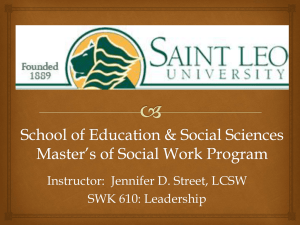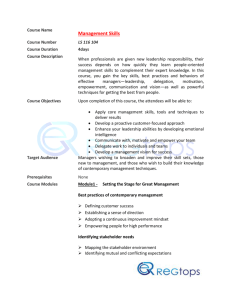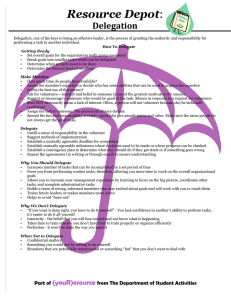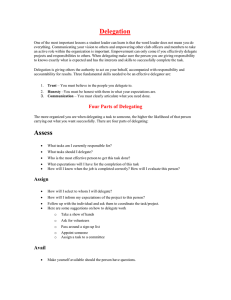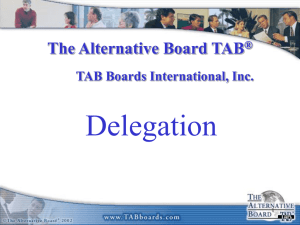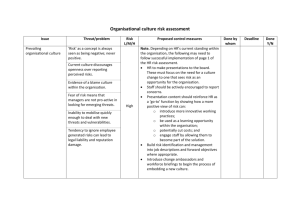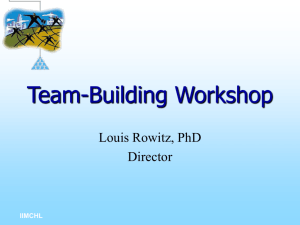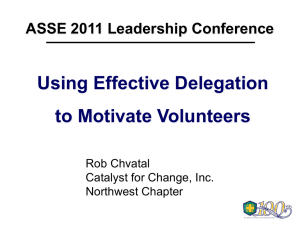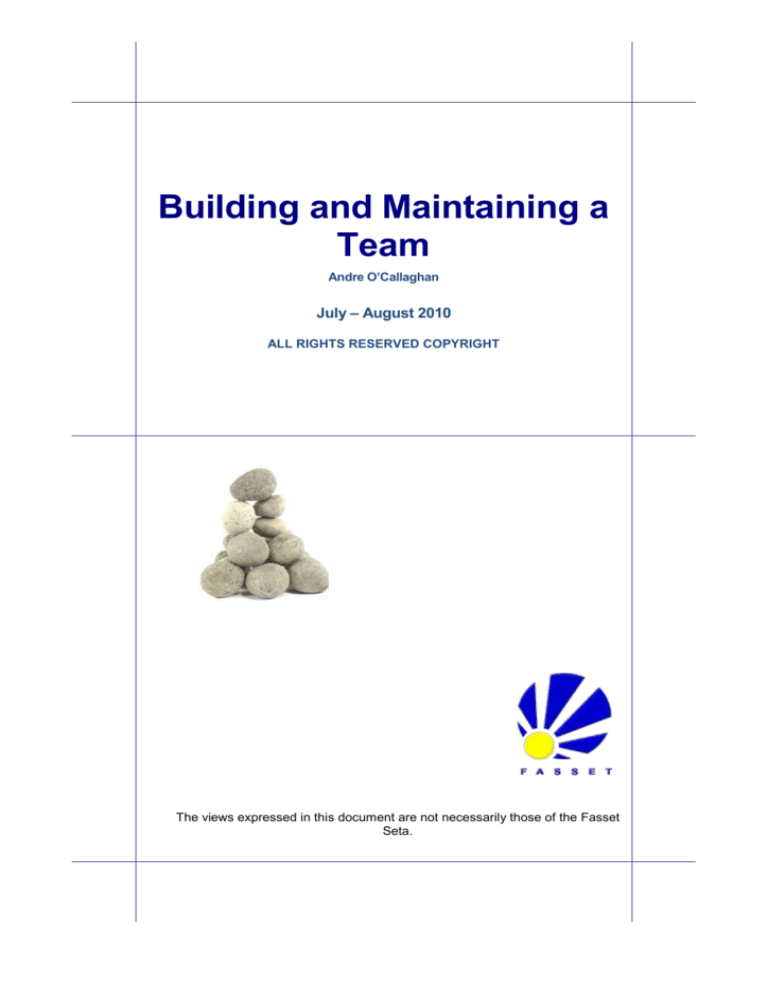
Building and Maintaining a
Team
Andre O’Callaghan
July – August 2010
ALL RIGHTS RESERVED COPYRIGHT
The views expressed in this document are not necessarily those of the Fasset
Seta.
SELF-ASSESSMENT QUESTIONS AND ANSWERS
This self-assessment has been designed to allow you to test the understanding and
knowledge that you have gained from attending the Fasset workshop on Building and
Maintaining a Team. It comprises 25 multiple-choice questions and should take you about 20
- 30 minutes to complete. Note that in some instances multiple answers may be correct.
Section
Description
1
Introduction to Team Building and Team Maintenance
2
Team Dynamics
3
Team Functions
4
Types of Teams and Their Purpose
5
Team Stages
6
Team-Building
7
Maintaining Teams
8
Team Leadership and Team Membership
9
Change in Teams
10
Future Trends
11
Political Intelligence in Teams
12
Team Reward and Recognition
13
Diversity in Teams
Building and Maintaining a Team
July - August 2010
2
SECTION 1
Introduction to Teams
1.
Effective teams can:
a. Be bought
b. Not be faked
c. Be created through trust and safety
d. Exist without having a common goal
2.
A team can only be a team when:
a. People know each other and willingly form a group
b. The principle of consultative decision-making is applied
c. They have a leader
d. Team members are interdependent
3.
Conditions for effective teaming include:
a. Adequate sharing amongst team members
b. A common purpose
c. Passion in the team
d. Commitment to the team
SECTION 2
Team Dynamics
4.
The key aspects of any team dynamic are:
a. Personalities of team members
b. Power games
c. Leadership
d. The climate in the team
5.
Key ingredients for accountability and engagement in a team are:
a. Team members’ emotional intelligence
b. Energy of team members and their attitude
c. Clarity of individual goals
d. The social networks in the team
SECTION 3
Team Functions
6.
All teams should have the following functions:
Building and Maintaining a Team
July - August 2010
3
a. Inspecting
b. Promoting
c. Driving
d. Compromising
SECTION 4
Types of teams and their purpose
7.
the following are examples of team types at work:
a. Social clubs
b. Project teams
c. Departments
d. Head offices
SECTION 5
Team Stages
8.
When a team is in its storming phase, the key leadership focus should be:
a. Providing strong direction
b. Facilitating interdependence
c. Allowing people to vent frustrations
d. Assisting with personal problems
9.
The behaviours/issues that you will see during the norming phase will include:
a. Roles are not accepted and responsibilities are ignored
b. Discussions are good and in depth
c. People listen to each other
d. People feel stuck
10.
In the first phase of group development, the forming phase the key tasks to complete
include:
a. Defining who is in charge
b. Get to know the skills and resources in the team
c. Confronting the hard issues
d. Asking for feedback
SECTION 6
Team Building
11.
Experiential team-building focuses on:
Building and Maintaining a Team
July - August 2010
4
a. Personal awareness and insights
b. Team behaviours and team leadership
c. Personal storytelling
d. Key performance areas
12.
Key building blocks for any team building should include:
a. Social get-togethers
b. Playing as a team
c. Defining a mission and vision
d. Giving people the opportunity to relax together
13.
Effective teams:
a. Play the politics better than other teams
b. Have more power
c. Never need to ask for help
d. Do not tolerate failure
SECTION 7
Maintaining teams
14.
One of the key traps in maintaining teams is:
a. Micromanaging the team
b. Delegation
c. Allowing failure
d. Having a team charter
15.
Delegation will be effective when:
a. You only delegate routine tasks
b. You delegate the tasks you don’t have the skills for
c. New tasks
d. You delegate responsibility and authority
16.
Innovation in teams are largely dependent on:
a. The IQ’s of team members
b. Personality types in the team
c. The team culture
d. Having clear rules
17.
When teams focus only on their own priorities and what is convenient for them, they
fell into the trap of:
a. Our world is the only world
Building and Maintaining a Team
July - August 2010
5
b. Poor communication
c. A lack of new stimuli
d. Reality distortion
18.
Toxic teams are the result of:
a. Diversity
b. Personality clashes
c. Negative attitudes
d. Poor structures
SECTION 8
Team Leadership and Team Membership
19.
To motivate a team you need to:
a. Know the theories of motivation
b. Show unconditional trust
c. Challenge the team
d. Be known to staff
20.
When a team is in its storming phase, the appropriate leadership style should be:
a. Validating
b. Collaborating
c. Structuring
d. Resolving
SECTION 9
Change in Teams
21.
The biggest factors impacting on how teams react to change include:
a. Perceptions of loss
b. Fear of the unknown
c. Lack of emotional resilience
d. Rumours
SECTION 10
Future teams
22.
Research suggests the following changes/trends in teams:
a. Team members will become increasingly older due to the quality of modern
healthcare
b. Sensitivity towards team members and the place of work will increase
c. Teams will have short-term focus
Building and Maintaining a Team
July - August 2010
6
d. Remote teams will be a large part of any organisation
SECTION 11
Political Intelligence in teams
23.
Political Awareness includes:
a. Interpersonal influence
b. Power positions
c. Ability to network
d. The ability to make deals and see trends
SECTION 12
Team Reward
24.
Reasons why leaders often neglect reward and recognition in teams are:
a. There is no time
b. They feel embarrassed to do it
c. They cannot afford it
d. They don’t believe in recognition
SECTION 13
Diversity in teams
25.
Diversity in teams are caused by:
a. Religion
b. The culture in the team
c. Gender ratio’s
d. Educational backgrounds
Building and Maintaining a Team
July - August 2010
7
ANSWERS
Building and Maintaining a Team
July - August 2010
Question
Answer
1
b&c
2
c&d
3
All of the above
4
b, c & c
5
b
6
a&b
7
b, c & d
8
c
9
b&c
10
b
11
b
12
c
13
None of the above
14
a
15
d
16
c
17
d
18
a, b & c
19
b&c
20
d
21
a&b
22
c&d
23
a&c
24
All of the above
25
a, c & d
8

